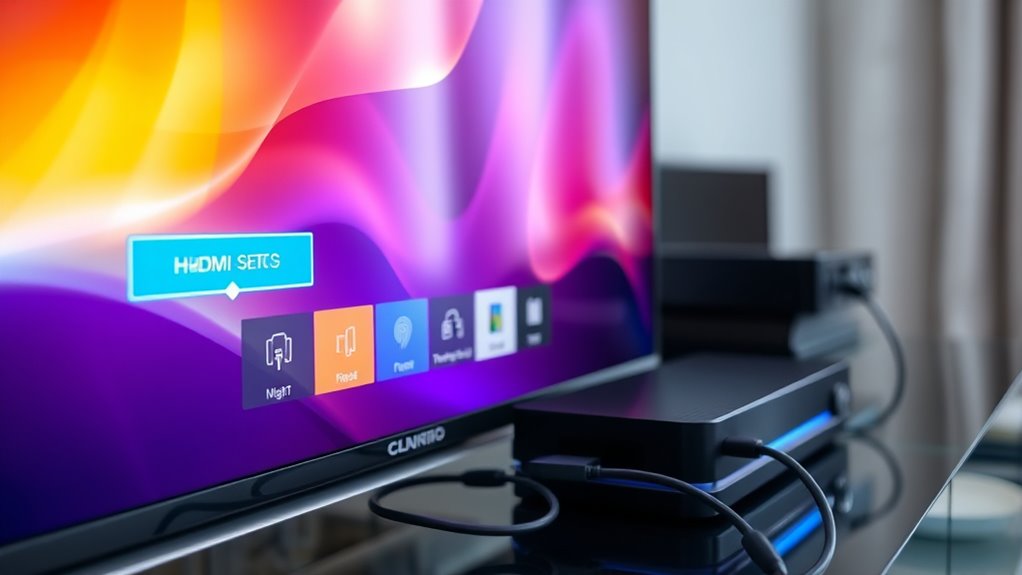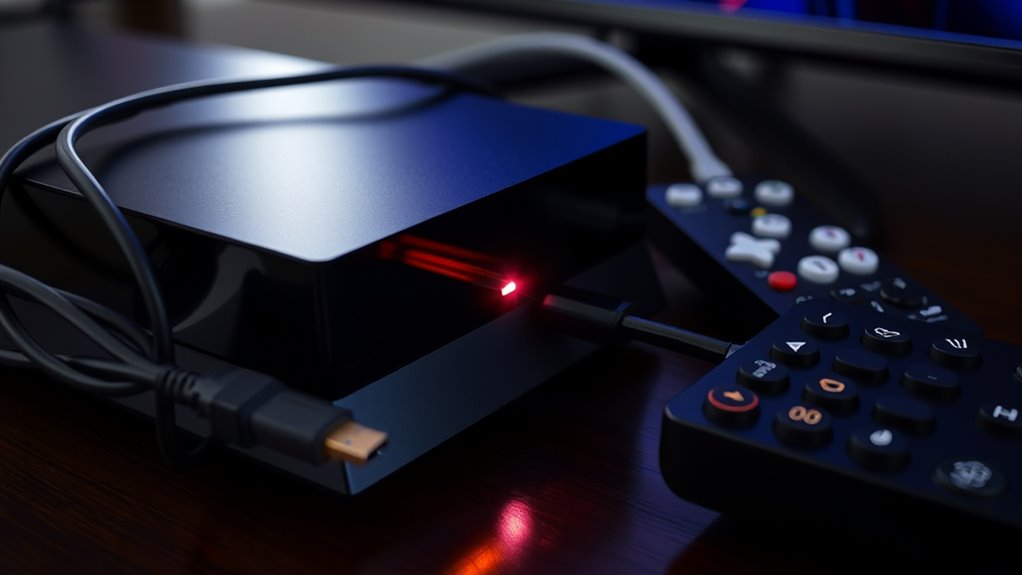If your HDMI-CEC isn’t turning off your console, it could be due to compatibility issues, incorrect settings, or power conflicts. Make sure all devices support HDMI-CEC and that it’s enabled on both your console and TV. Check your power options to prevent auto-on features. Faulty cables or ports, outdated firmware, or hardware problems can also cause the issue. Keep exploring to discover more ways to fix this common problem.
Key Takeaways
- Compatibility issues or outdated firmware can prevent the console from responding to HDMI-CEC shutdown commands.
- Improper power settings, like “Instant On,” may keep the console partially active despite CEC signals.
- Hardware damage or faulty HDMI ports can disrupt communication, causing shutdown failures via HDMI-CEC.
- Conflicting device controls or auto-on features can interfere with the console’s ability to turn off automatically.
- Ensuring HDMI-CEC is enabled and using working cables helps resolve communication problems affecting shutdown.
Compatibility Issues Between Devices

Compatibility issues between devices often cause HDMI-CEC to malfunction or fail to turn off your console. Not all devices support HDMI-CEC fully, or they may implement it differently. For example, your TV might not recognize signals from your gaming console, or the console might not communicate properly with the soundbar. Different manufacturers may also have incompatible HDMI-CEC protocols, leading to communication breakdowns. If your devices aren’t designed to work together seamlessly, commands like turning off your console may not pass through correctly. Additionally, outdated firmware or hardware limitations can hinder compatibility, preventing HDMI-CEC from functioning as intended. Ensuring that your devices are compatible and support HDMI-CEC properly is essential for smooth operation. Understanding compatibility is key to troubleshooting and resolving these issues effectively.
Incorrect HDMI-CEC Settings

Incorrect HDMI-CEC settings are a common reason your console refuses to turn off automatically. If the feature isn’t properly enabled or configured, your devices won’t communicate effectively, preventing your console from shutting down as intended. Make sure HDMI-CEC is activated on both your console and TV. Check for any settings that may disable or limit CEC functionality. Sometimes, a simple reset of these settings can resolve issues. Also, verify that your devices are connected via HDMI and that no firmware updates are pending, as outdated software can interfere with HDMI-CEC signals. Ensuring your devices are compatible and support HDMI-CEC standards can also improve communication and functionality.
Power Settings on Your Console

Adjusting your console’s power settings can help guarantee it turns off properly when you intend. Many consoles have power options that influence how they behave during shutdown and standby modes. Confirm your settings are configured for complete shutdown rather than low-power standby, which can keep the system partially active and interfere with HDMI-CEC commands. On most consoles, you can find these settings in the system menu under power or energy options. Disable any features like “Instant On” or “Quick Resume” that keep the system partially awake. Setting the console to fully turn off when powered down ensures it responds correctly to HDMI-CEC signals, preventing it from staying on unintentionally. Proper power configuration is key to seamless integration with your TV’s HDMI-CEC functions.
Faulty HDMI Cables or Ports

Even with your console’s power settings properly configured, issues with HDMI-CEC might persist if there are problems with the cables or ports. Damaged or low-quality HDMI cables can cause communication errors, preventing your device from turning off correctly. Similarly, dirty or loose ports can disrupt the signal, leading to inconsistent performance. Faulty ports on your console or TV may also be the culprit, blocking proper data transfer. To troubleshoot, check for visible damage on cables, ensure they’re firmly connected, and test with a different cable or port. Sometimes, simply replacing a worn-out cable or cleaning the ports can resolve the issue, restoring smooth HDMI-CEC operation. Ensuring that your devices support HDMI-CEC standards is also crucial for proper functionality.
Firmware or Software Outdated

Outdated firmware or software on your console can interfere with HDMI-CEC functionality, causing it to fail in turning off your device properly. When your console’s system isn’t current, it may not communicate effectively with connected devices, like your TV or sound system. Manufacturers release updates to fix bugs, improve compatibility, and enhance features, including HDMI-CEC. If you haven’t updated your console recently, these issues could be the reason your device doesn’t turn off as intended. To fix this, check for firmware or software updates in your console’s settings menu. Installing the latest version often resolves compatibility problems and restores proper HDMI-CEC operation. Keeping your console updated is a straightforward yet vital step to ensure seamless device control.
Conflicting Device Commands

Conflicting device commands happen when multiple devices try to control the same functions, causing confusion for HDMI-CEC. You might find your console turning on or off unexpectedly because of overlapping controls or power conflicts. Automatic device activation can also trigger unintended actions, making it harder to manage your setup smoothly. Additionally, issues with device compatibility can lead to inconsistent behavior in how commands are executed across your devices.
Overlapping Device Controls
When multiple devices on your HDMI-CEC network try to control the same function, their commands can clash, leading to unexpected behavior. For example, your TV might attempt to turn off your console while your soundbar sends a power-on command, causing confusion. These overlapping controls happen when devices interpret each other’s signals differently or have conflicting settings. To minimize issues, consider these tips:
- Disable CEC functions on devices that don’t need control over each other
- Use a single device as the primary control source
- Update device firmware to improve CEC communication
- Check device settings for conflicting control options
- Device compatibility can also influence how well devices communicate and follow commands.
Power Command Conflicts
Power command conflicts occur when multiple devices send contradictory signals to control your console’s power state. For example, your TV might send a command to turn on, while your soundbar or other connected device sends a command to turn off. These conflicting signals create confusion within the HDMI-CEC system, preventing your console from turning off properly. You might notice that your console remains on despite attempts to power it down, or it keeps turning back on unexpectedly. To fix this, check the settings on all connected devices and disable any automatic power control features that could interfere. Ensuring that only one device has authority over power commands helps prevent conflicts and allows your console to turn off as intended. Additionally, understanding the building tension and dynamic contrasts in trailer music can help you craft more impactful compositions that resonate emotionally with viewers.
Automatic Device Activation
Automatic device activation occurs when connected devices send commands that unintentionally turn your console on or off without your input. This can happen if your TV, soundbar, or other HDMI devices send power signals that conflict with your console’s settings. These commands might be triggered by standby modes, auto-on features, or device-specific settings that don’t sync properly. As a result, your console might turn on unexpectedly or refuse to turn off. To prevent this, check each device’s HDMI-CEC settings and disable auto power functions if needed. Understanding which devices send these commands helps you control your setup better.
- Confirm all devices have HDMI-CEC disabled if unnecessary
- Turn off auto power or standby features on connected devices
- Use separate input sources to avoid signal conflicts
- Regularly update device firmware for maximum compatibility
Hardware Malfunctions or Defects

Hardware malfunctions or defects can cause your console to ignore HDMI-CEC commands, preventing it from turning off properly. If your console’s HDMI port or internal components are damaged, it might not respond to signals from your TV or receiver. Faulty HDMI cables or ports can also disrupt communication, making it seem like HDMI-CEC isn’t working when the issue is hardware-related. Additionally, internal hardware defects, such as a malfunctioning motherboard or power supply, can interfere with the console’s ability to process shutdown commands. If you’ve tried troubleshooting software settings and the problem persists, hardware flaws are likely the cause. In such cases, repairing or replacing the affected hardware parts becomes necessary to restore proper HDMI-CEC functionality. User privacy considerations are also important when dealing with hardware issues that involve diagnostics or repairs.
Frequently Asked Questions
Can Hdmi‑Cec Issues Affect Only Specific Devices or All Connected Devices?
HDMI‑CEC issues can affect either specific devices or all connected ones, depending on the problem. If only one device isn’t responding, it might have a settings issue or compatibility problem. However, if multiple devices aren’t working correctly, the issue likely stems from your TV or HDMI hub’s settings or firmware. You should check all device settings and update firmware to troubleshoot and fix the problem effectively.
How Do I Reset My Console’S Hdmi‑Cec Settings to Default?
To reset your console’s HDMI-CEC settings to default, first turn off your console and disconnect it from power. Then, access your console’s settings menu, look for the HDMI or display settings, and find the option to reset or restore defaults. Select this option, confirm your choice, and restart your console. This process clears any custom HDMI-CEC configurations, restoring the default setup for proper device communication.
Is There a Way to Test if My Hdmi‑Cec Feature Is Working Properly?
You can test if your HDMI-CEC feature works by turning on both your console and TV. Use your TV remote to navigate to HDMI-CEC settings and verify it’s enabled. Then, turn on your console and see if your TV automatically switches to the correct input. If it does, CEC is functioning properly. If not, double-check your settings and try restarting both devices to troubleshoot.
Do Firmware Updates Automatically Fix Hdmi‑Cec Compatibility Problems?
Firmware updates can often fix HDMI-CEC compatibility issues, so it’s worth keeping your device up to date. When you install the latest updates, developers address known bugs and improve functionality, which may resolve your HDMI-CEC problems. However, updates don’t guarantee a fix every time, so if you’re still experiencing issues after updating, consider checking your device settings or cables for potential causes.
Imagine your home’s wiring suddenly sparks and flickers, signaling a problem beneath the surface. Common signs of hardware issues with HDMI-CEC include your devices not syncing correctly, unexpected power ons or offs, or the console remaining stuck in a certain state. You might also notice flickering screens or delayed responses. These signs point to underlying hardware malfunctions that disrupt communication, much like faulty wiring causes flickers and outages in your home.
Conclusion
If your HDMI-CEC isn’t turning off your console, you’re not alone—about 30% of users experience this issue at some point. Double-check your device compatibility, settings, and cables first. Keep your firmware updated to avoid glitches. Remember, hardware defects can also be the culprit. Taking these steps can often fix the problem quickly, ensuring smoother entertainment. Don’t let technical hiccups spoil your viewing—troubleshoot, and enjoy seamless control again!

